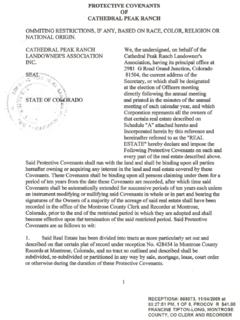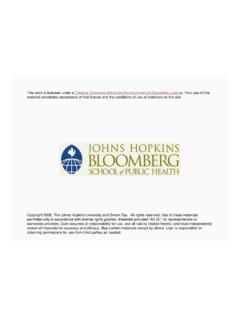Transcription of Employment Insurance, Who is Exempt? - Ledgers
1 Your local Ledgers Professional is: Dilip Chetram, MBA Tel: 416-412-3625 1 - Employment insurance , Who is exempt ? COPYRIGHT Ledgers Canada All rights reserved. No part of this manual may be reproduced in whole or in part, stored in a retrieval system, or transmitted, in any form or by any means (photocopying, faxing, electronic, mechanical, recording or otherwise) without the prior written permission of the copyright holder and publisher. Your local Ledgers Professional is: Dilip Chetram, MBA Tel: 416-412-3625 2 - Table of Contents Table of Contents ..2 Overview ..3 What is EI? .. 4 Types of Benefits .. 4 Determining Eligibility .. 5 EI Benefits 6 Excluded Employment and Earnings ..7 Employer Employee 7 Employee or Self-Employed?
2 7 Factors used to Determine Status .. 8 Personal 8 Excluded Earnings and 9 EI for Related Parties .. 10 Requesting a Ruling from CRA ..11 Completing form CPT1 .. 11 Appealing a CRA Ruling ..14 Who can file an appeal? .. 14 When must an appeal be filed? .. 14 Other Considerations:.. 14 Refunds of Overpayments ..15 Who can apply for a refund? .. 15 When must the application be filed?.. 15 Other Considerations:.. 15 Reducing EI Basic Requirements of the Plan .. 16 What are the Savings? .. 16 Other Information:.. 17 EI and Income Splitting ..18 Other Guides and Information available from Ledgers :..20 Your local Ledgers Professional is: Dilip Chetram, MBA Tel: 416-412-3625 3 - Overview This information circular will outline the rules and requirements relating to the treatment of Employment insurance (EI) premiums and benefits for individuals that could be exempt or otherwise ineligible.
3 Determining eligibility in advance of making payroll deductions and remittances could save a business a considerable amount of time and money as well as preventing the individual concerned from being deemed ineligible for benefits when they make their application. This Guide will be separated into the following sections: What is EI? Types of EI Benefits Determining Eligibility Employee or Self-Employed? Excluded Earnings and Occupations EI for Related Parties Request for Ruling Filing an Appeal Refunds of Overpayments Reduced EI premiums The information contained herein is intended for reference purposes only, when a question arises, you should always consult the appropriate CRA Guides or other resources as may be necessary.
4 This guide is divided into sections for each relevant topic, The Table of Contents references are active links, in other words, if you click on a line in the Table of Contents, it will take you to that page. Sections of this manual may refer to Interpretation bulletins, CRA tax guides, Forms and other materials. When possible, a referred guide or form may be accessed by clicking on the referenced hyperlink. These links in most cases will refer you to a web page; therefore, your Internet connection should be active. Example link: (CRA Interpretation Bulletin IT-221R3) Your local Ledgers Professional is: Dilip Chetram, MBA Tel: 416-412-3625 4 - What is EI? (more information) Employment insurance is a temporary financial assistance program administered by Human Resources and Social Development Canada (HRSDC).
5 This agency, formerly know as Human Resources Development Canada (HRDC) is responsible for making EI payments and determining the type of benefits an individual may be entitled to, they do not however determine eligibility for coverage. Eligibility (Insurable Earnings) is determined by The Canada Revenue Agency (CRA). (see determining eligibility section of this guide for more information) EI is designed to provide assistance to individuals that have become unemployed for a number of reasons or have left Employment due to illness or to upgrade their skills. Types of Benefits (more information) There are 6 types of benefits potentially available to an individual that meets eligibility requirements: Regular Benefits Illness or Injury Related Benefits Maternity and Parental Benefits Fishing Benefits Benefits for Specific Situations Compassionate Care Benefits ** New Legislation** Regular Benefits are paid to individuals that lose their jobs due to no fault of their own.
6 Examples of qualifying individuals would be: Loss of Employment due to a shortage of work with the employer Business closes for a specific time period (seasonal Employment ) The business closes permanently due to bankruptcy The business discontinues the position for which the individual was employed Illness or Injury Benefits are paid to individuals that cannot work due to illness, injury or quarantine. Benefits will be paid to qualifying individuals that provide a medical certificate that documents the nature of the injury / illness and the expected duration. In addition, the individual must be able to prove they would be otherwise available for work if they were not ill or injured. Examples of qualifying individuals would be: An individual unable to work due to an injury from an automobile collision An individual suffering a heart attack or other serious health condition An individual quarantined by the Department of Health due to their contact with a communicable disease Maternity and Parental Benefits Maternity benefits are paid to individuals that are the birth mother (or surrogate mother) of a newborn child.
7 Parental benefits may be paid to an individual that is either the biological parent or the adopted parent of a child (either newborn or newly adopted). In most cases, parental benefits can be shared between the parents or taken entirely by one individual. Fishing Benefits are paid to individuals that are Self-Employed in the fishing industry (see Employee or Self Employed Section of this guide for determination). If an individual is not self-employed but works in the fishing industry, they may qualify for one of the other types of benefits. Your local Ledgers Professional is: Dilip Chetram, MBA Tel: 416-412-3625 5 - Benefits for Specific Situations Persons employed in specific situations may qualify for benefits depending upon very certain terms and conditions, examples of special circumstances include: Teachers (more information) Self-Employed Farmers and Independent Workers (more information) Workers and Residents Outside of Canada (more information) Compassionate Care Leave NEW as of January 4th, 2004.
8 An individual that must be absent from work to care for or to provide support for a member of their immediate family may qualify for benefits. The family member must be at risk of death within the following 26 weeks. Family Member has different definitions under the Employment Standards Acts in Canada, however, for the purposes of claiming benefits, HRSDC defines a family member as: Your Child, or the child of your spouse Your spouse Your Mother/Father Your spouses Mother or Father In all instances, spouse includes common-law partners Although this is a Federal Program, most provinces are in the process of introducing similar legislation under their respective Employment Standards Acts.
9 Determining Eligibility There are a considerable number of eligibility requirements for each type of benefit. Eligibility is determined by examining a number of criteria including: Insurable Employment / Earnings Insurable Hours Qualifying Period Insurable Employment CRA has specific rules of determining whether or not an individual s Employment is insurable. Insurable Employment includes most Employment in Canada providing there exists an employee / employer relationship. However, there are situations where a review of the conditions of Employment will have to take place in order to determine eligibility, including: Employee or Self-Employed Employment with Related Parties Owners and Shareholders Special employees including Taxi Drivers, Hairdressers and Fishermen Each of these situations is discussed later in this guide.
10 Insurable Earnings are the amount of pay received for the number of hours worked in insurable Employment for the qualifying period. Insurable earnings generally include: Wages, salaries and other similar types of compensation Tips and Gratuities Benefits Paid to an employee in cash or in kind (taxable benefits) Your local Ledgers Professional is: Dilip Chetram, MBA Tel: 416-412-3625 6 - Insurable Hours An individual must generally work a predetermined number of hours during the qualifying period to be eligible for EI benefits. The number of hours varies depending upon: The type of Employment The location of the Employment The type of benefits being applied for The location (province) of Employment has a significant impact upon the number of insurable hours required for eligibility, all dependant upon the Regional Rate of Unemployment.






